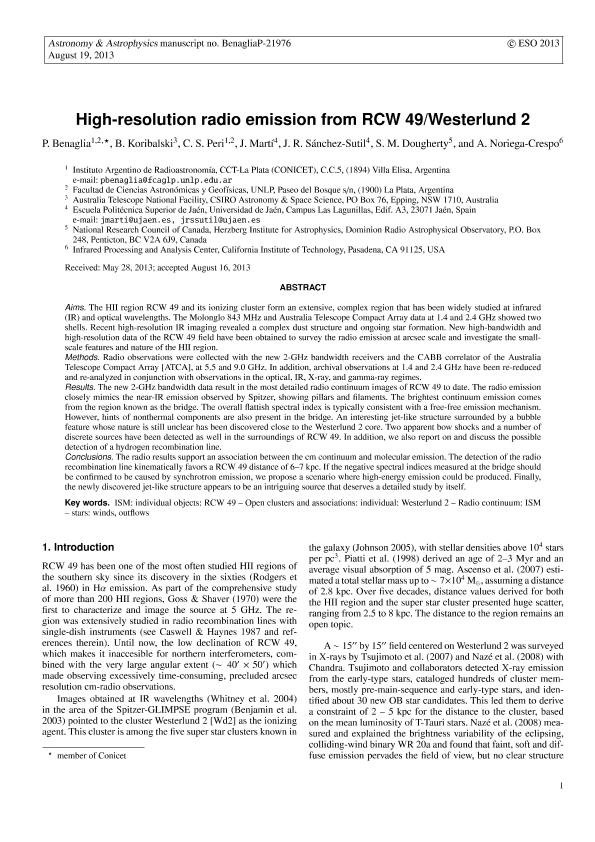Artículo
High-resolution radio emission from RCW 49/Westerlund 2
Peri, Cintia Soledad ; Benaglia, Paula
; Benaglia, Paula ; Koribalski, Bärbel Silvia; Dougherty, Sean Melbourne; Noriega-crespo, Alberto; Sánchez Sutil, Juan R.; Martí, Josep
; Koribalski, Bärbel Silvia; Dougherty, Sean Melbourne; Noriega-crespo, Alberto; Sánchez Sutil, Juan R.; Martí, Josep
 ; Benaglia, Paula
; Benaglia, Paula ; Koribalski, Bärbel Silvia; Dougherty, Sean Melbourne; Noriega-crespo, Alberto; Sánchez Sutil, Juan R.; Martí, Josep
; Koribalski, Bärbel Silvia; Dougherty, Sean Melbourne; Noriega-crespo, Alberto; Sánchez Sutil, Juan R.; Martí, Josep
Fecha de publicación:
12/2013
Editorial:
EDP Sciences
Revista:
Astronomy and Astrophysics
ISSN:
0004-6361
Idioma:
Inglés
Tipo de recurso:
Artículo publicado
Clasificación temática:
Resumen
Aims. The HII region RCW49 and its ionizing cluster form an extensive, complex region that has been widely studied at infrared (IR) and optical wavelengths. The Molonglo 843 MHz and Australia Telescope Compact Array data at 1.4 and 2.4 GHz showed two shells. Recent high-resolution IR imaging revealed a complex dust structure and ongoing star formation. New high-bandwidth and high-resolution data of the RCW 49 field have been obtained to survey the radio emission at arcsec scale and investigate the smallscale features and nature of the HII region. Methods. Radio observations were collected with the new 2-GHz bandwidth receivers and the CABB correlator of the Australia Telescope Compact Array [ATCA], at 5.5 and 9.0 GHz. In addition, archival observations at 1.4 and 2.4 GHz have been re-reduced and re-analyzed in conjunction with observations in the optical, IR, X-ray, and gamma-ray regimes. Results. The new 2-GHz bandwidth data result in the most detailed radio continuum images of RCW 49 to date. The radio emission closely mimics the near-IR emission observed by Spitzer, showing pillars and filaments. The brightest continuum emission comes from the region known as the bridge. The overall flattish spectral index is typically consistent with a free-free emission mechanism. However, hints of nonthermal components are also present in the bridge. An interesting jet-like structure surrounded by a bubble feature whose nature is still unclear has been discovered close to the Westerlund 2 core. Two apparent bow shocks and a number of discrete sources have been detected as well in the surroundings of RCW 49. In addition, we also report on and discuss the possible detection of a hydrogen recombination line. Conclusions. The radio results support an association between the cm continuum and molecular emission. The detection of the radio recombination line kinematically favors a RCW49 distance of 6-7 kpc. If the negative spectral indices measured at the bridge should be confirmed to be caused by synchrotron emission, we propose a scenario where high-energy emission could be produced. Finally, the newly discovered jet-like structure appears to be an intriguing source that deserves a detailed study by itself.
Archivos asociados
Licencia
Identificadores
Colecciones
Articulos(IAR)
Articulos de INST.ARG.DE RADIOASTRONOMIA (I)
Articulos de INST.ARG.DE RADIOASTRONOMIA (I)
Citación
Peri, Cintia Soledad; Benaglia, Paula; Koribalski, Bärbel Silvia; Dougherty, Sean Melbourne; Noriega-crespo, Alberto; et al.; High-resolution radio emission from RCW 49/Westerlund 2; EDP Sciences; Astronomy and Astrophysics; 559; 12-2013; 31-39
Compartir
Altmétricas



